Abstract
We have evaluated the value of specific bone resorption markers in monitoring metastatic bone disease to define the duration of action of a single high-dose pamidronate infusion. Twenty patients received a single infusion of pamidronate 120 mg for painful bone metastases. Ten out of these 20 patients also received a second infusion. They were evaluated at baseline, 2, 4 and 8 weeks after each infusion. A composite pain questionnaire, serum and urine tests were carried out at these time points. Bone resorption markers measured included urinary calcium, hydroxyproline and two new markers: pyridinoline and deoxypyridinoline. Reference values were defined by 20 healthy controls matched by age and sex. Pamidronate induced a profound fall in bone resorption with a maximal effect within the first month after therapy. Changes in urinary calcium levels were confounded by a rise of 100% in the parathyroid hormone levels. Before treatment, pyridinoline and deoxypyridinoline were increased in 70% of patients, while urinary calcium was increased in only 40% of them. Thirteen patients had a > or = 50% fall in deoxypyridinoline levels and were considered as biochemical responders. These patients had a mean reduction in pain score of about 30% of baseline levels, which was significantly higher than the seven non-biochemical responders. In conclusion, urinary calcium is not a precise marker of bone resorption. Deoxypyridinoline seems to be the most specific bone resorption marker in cancer patients. Biochemical responders have the most benefit from pamidronate in terms of pain relief. This suggests that patients may benefit from more potent or repeated infusions of bisphosphonates.
Full text
PDF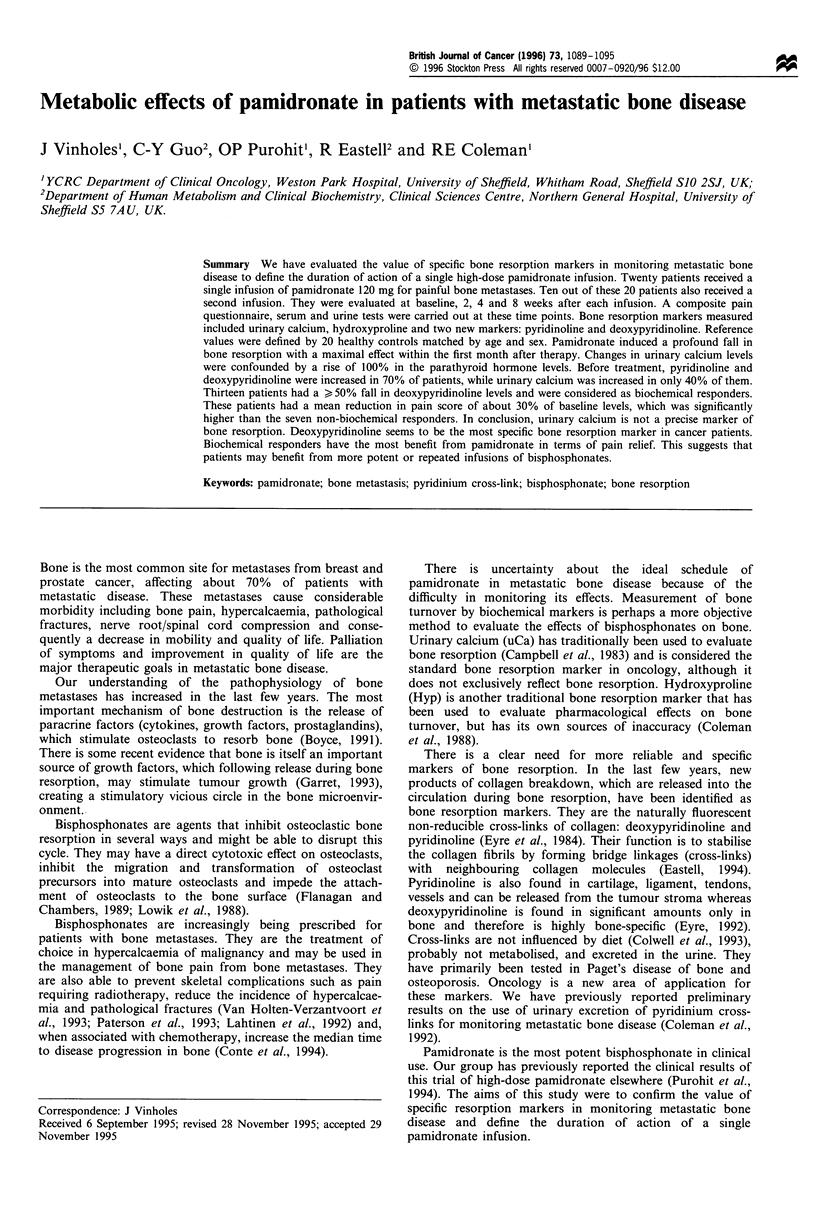
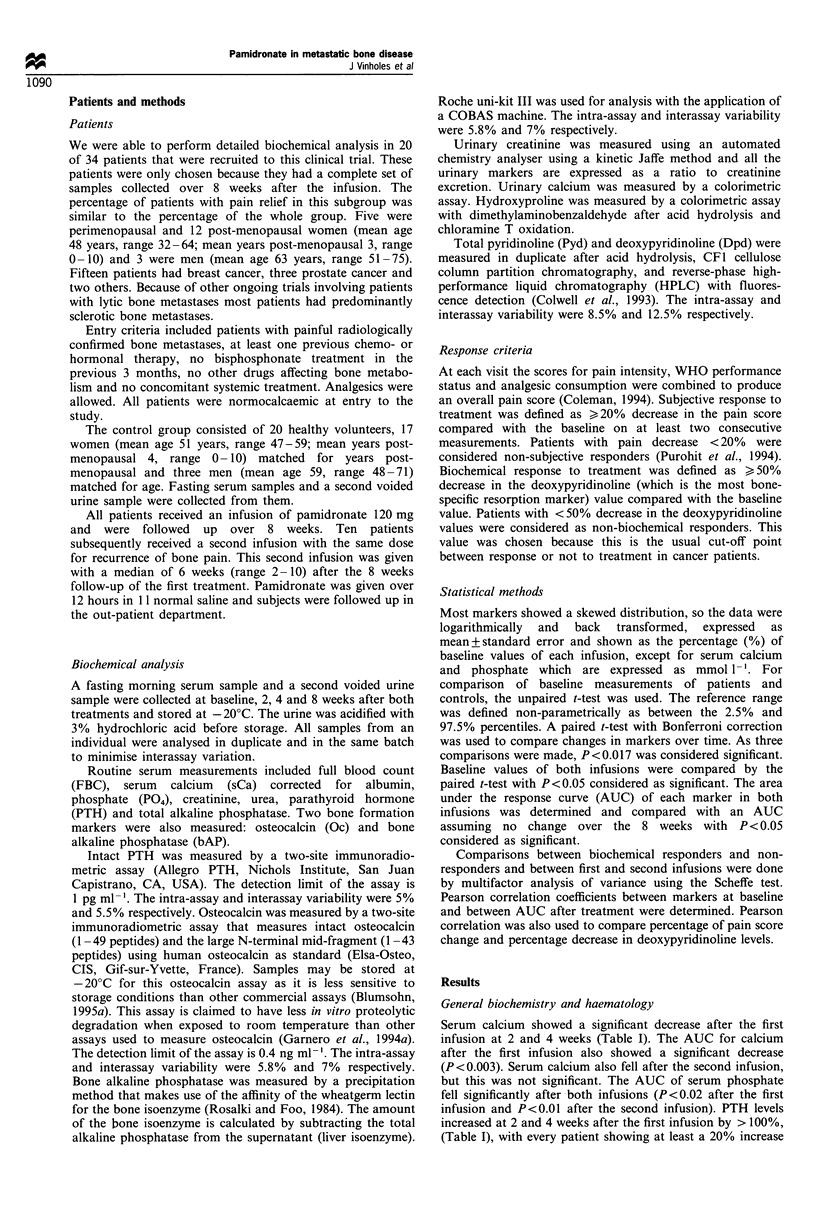
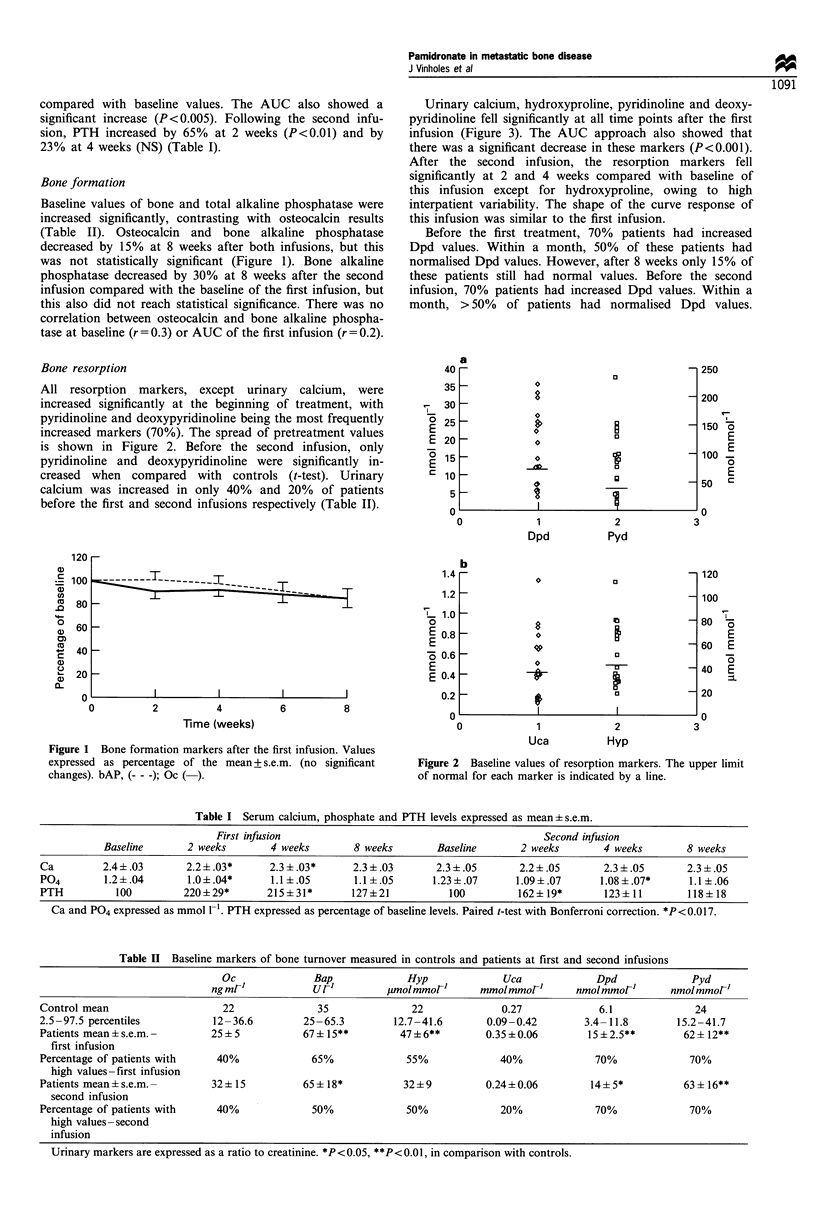
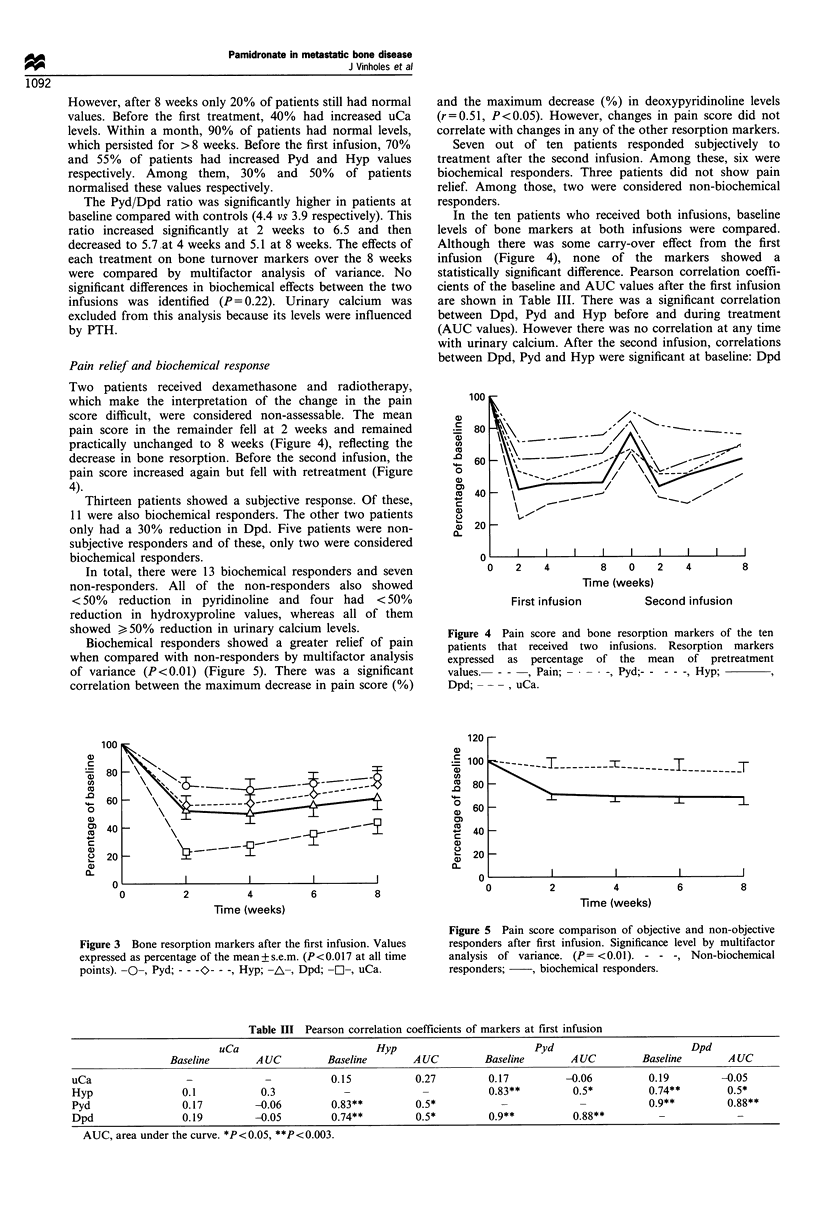
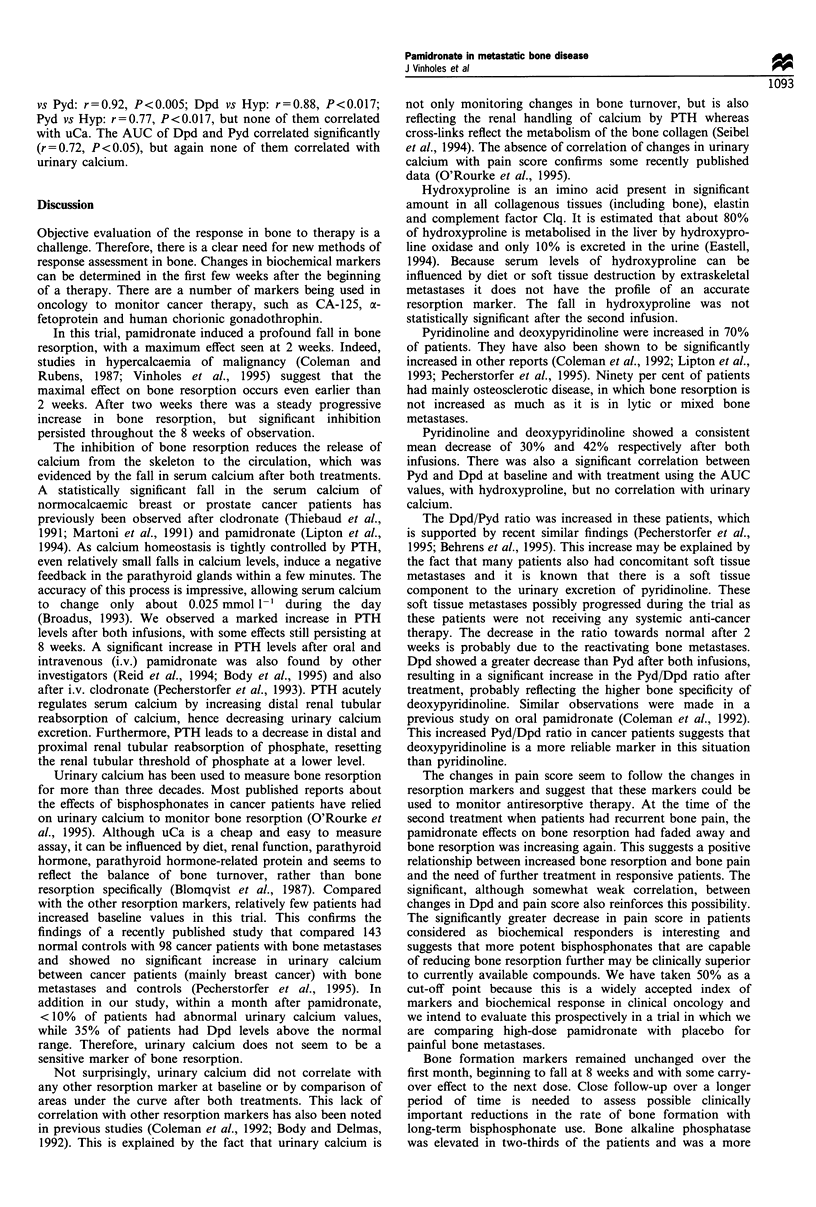
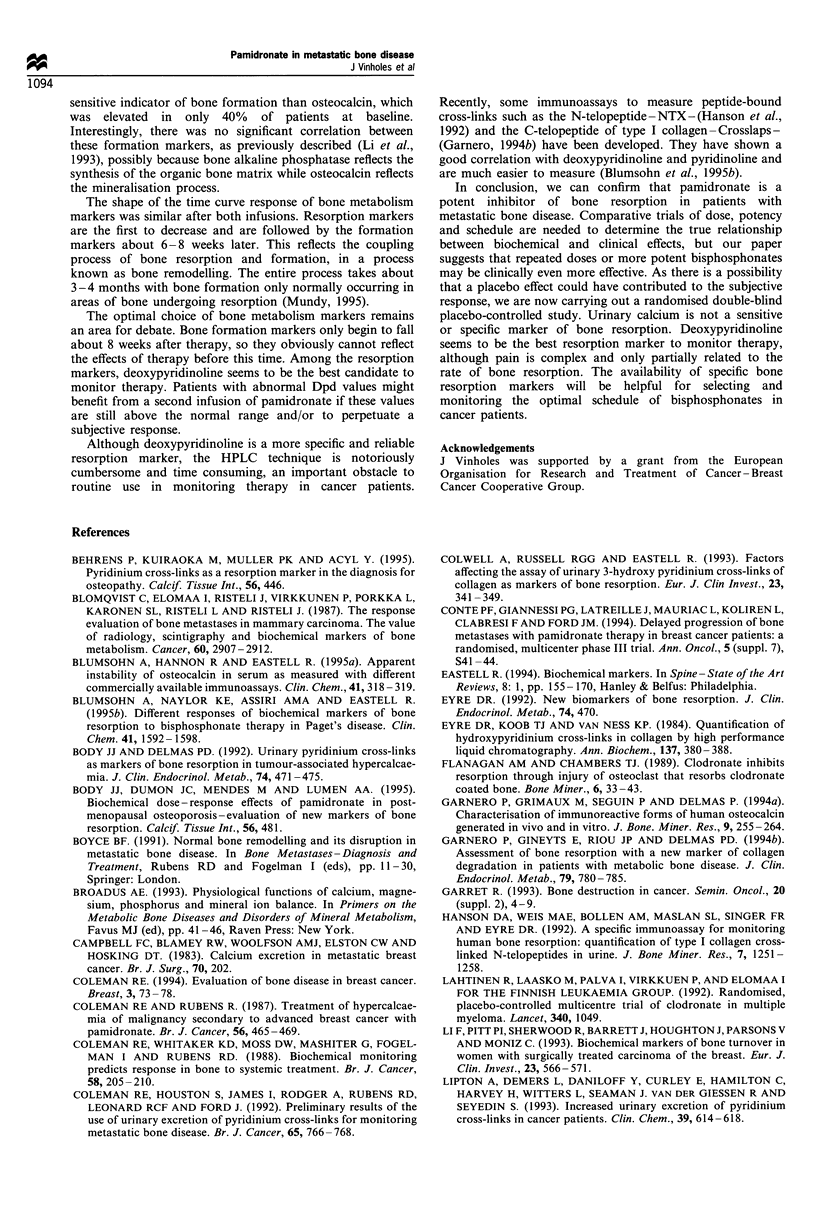
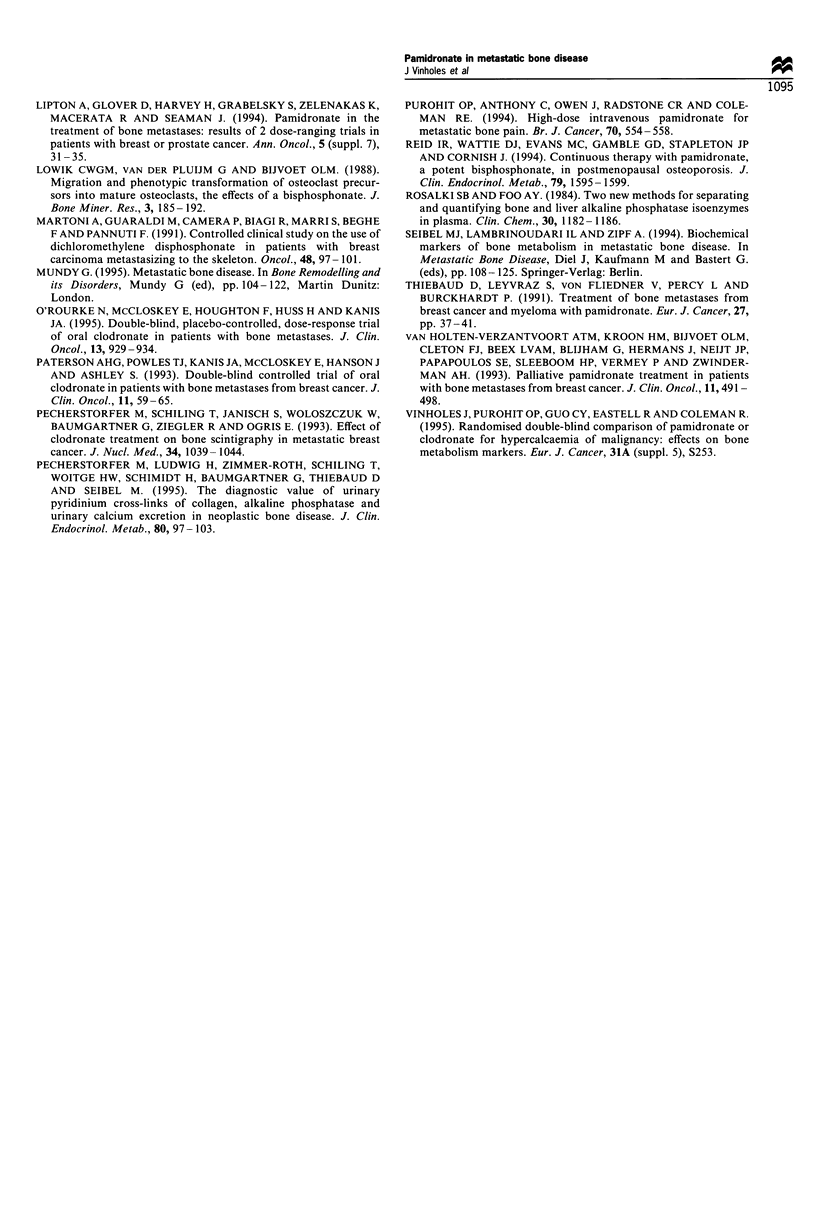
Selected References
These references are in PubMed. This may not be the complete list of references from this article.
- Blomqvist C., Elomaa I., Virkkunen P., Porkka L., Karonen S. L., Risteli L., Risteli J. The response evaluation of bone metastases in mammary carcinoma. The value of radiology, scintigraphy, and biochemical markers of bone metabolism. Cancer. 1987 Dec 15;60(12):2907–2912. doi: 10.1002/1097-0142(19871215)60:12<2907::aid-cncr2820601211>3.0.co;2-b. [DOI] [PubMed] [Google Scholar]
- Blumsohn A., Hannon R. A., Eastell R. Apparent instability of osteocalcin in serum as measured with different commercially available immunoassays. Clin Chem. 1995 Feb;41(2):318–319. [PubMed] [Google Scholar]
- Blumsohn A., Naylor K. E., Assiri A. M., Eastell R. Different responses of biochemical markers of bone resorption to bisphosphonate therapy in Paget disease. Clin Chem. 1995 Nov;41(11):1592–1598. [PubMed] [Google Scholar]
- Body J. J., Delmas P. D. Urinary pyridinium cross-links as markers of bone resorption in tumor-associated hypercalcemia. J Clin Endocrinol Metab. 1992 Mar;74(3):471–475. doi: 10.1210/jcem.74.3.1740478. [DOI] [PubMed] [Google Scholar]
- Campbell F. C., Blamey R. W., Woolfson A. M., Elston C. W., Hosking D. J. Calcium excretion (CaE) in metastatic breast cancer. Br J Surg. 1983 Apr;70(4):202–204. doi: 10.1002/bjs.1800700405. [DOI] [PubMed] [Google Scholar]
- Coleman R. E., Houston S., James I., Rodger A., Rubens R. D., Leonard R. C., Ford J. Preliminary results of the use of urinary excretion of pyridinium crosslinks for monitoring metastatic bone disease. Br J Cancer. 1992 May;65(5):766–768. doi: 10.1038/bjc.1992.161. [DOI] [PMC free article] [PubMed] [Google Scholar]
- Coleman R. E., Rubens R. D. 3(Amino-1,1-hydroxypropylidene) bisphosphonate (APD) for hypercalcaemia of breast cancer. Br J Cancer. 1987 Oct;56(4):465–469. doi: 10.1038/bjc.1987.225. [DOI] [PMC free article] [PubMed] [Google Scholar]
- Coleman R. E., Whitaker K. B., Moss D. W., Mashiter G., Fogelman I., Rubens R. D. Biochemical prediction of response of bone metastases to treatment. Br J Cancer. 1988 Aug;58(2):205–210. doi: 10.1038/bjc.1988.194. [DOI] [PMC free article] [PubMed] [Google Scholar]
- Colwell A., Russell R. G., Eastell R. Factors affecting the assay of urinary 3-hydroxy pyridinium crosslinks of collagen as markers of bone resorption. Eur J Clin Invest. 1993 Jun;23(6):341–349. doi: 10.1111/j.1365-2362.1993.tb02034.x. [DOI] [PubMed] [Google Scholar]
- Eyre D. R., Koob T. J., Van Ness K. P. Quantitation of hydroxypyridinium crosslinks in collagen by high-performance liquid chromatography. Anal Biochem. 1984 Mar;137(2):380–388. doi: 10.1016/0003-2697(84)90101-5. [DOI] [PubMed] [Google Scholar]
- Flanagan A. M., Chambers T. J. Dichloromethylenebisphosphonate (Cl2MBP) inhibits bone resorption through injury to osteoclasts that resorb Cl2MBP-coated bone. Bone Miner. 1989 Apr;6(1):33–43. doi: 10.1016/0169-6009(89)90021-4. [DOI] [PubMed] [Google Scholar]
- Garnero P., Gineyts E., Riou J. P., Delmas P. D. Assessment of bone resorption with a new marker of collagen degradation in patients with metabolic bone disease. J Clin Endocrinol Metab. 1994 Sep;79(3):780–785. doi: 10.1210/jcem.79.3.8077361. [DOI] [PubMed] [Google Scholar]
- Garnero P., Grimaux M., Seguin P., Delmas P. D. Characterization of immunoreactive forms of human osteocalcin generated in vivo and in vitro. J Bone Miner Res. 1994 Feb;9(2):255–264. doi: 10.1002/jbmr.5650090215. [DOI] [PubMed] [Google Scholar]
- Hanson D. A., Weis M. A., Bollen A. M., Maslan S. L., Singer F. R., Eyre D. R. A specific immunoassay for monitoring human bone resorption: quantitation of type I collagen cross-linked N-telopeptides in urine. J Bone Miner Res. 1992 Nov;7(11):1251–1258. doi: 10.1002/jbmr.5650071119. [DOI] [PubMed] [Google Scholar]
- Lahtinen R., Laakso M., Palva I., Virkkunen P., Elomaa I. Randomised, placebo-controlled multicentre trial of clodronate in multiple myeloma. Finnish Leukaemia Group. Lancet. 1992 Oct 31;340(8827):1049–1052. doi: 10.1016/0140-6736(92)93075-x. [DOI] [PubMed] [Google Scholar]
- Li F., Pitt P. I., Sherwood R., Barrett J., Houghton J., Parsons V., Moniz C. Biochemical markers of bone turnover in women with surgically treated carcinoma of the breast. Eur J Clin Invest. 1993 Sep;23(9):566–571. doi: 10.1111/j.1365-2362.1993.tb00967.x. [DOI] [PubMed] [Google Scholar]
- Lipton A., Demers L., Daniloff Y., Curley E., Hamilton C., Harvey H., Witters L., Seaman J., Van der Giessen R., Seyedin S. Increased urinary excretion of pyridinium cross-links in cancer patients. Clin Chem. 1993 Apr;39(4):614–618. [PubMed] [Google Scholar]
- Löwik C. W., van der Pluijm G., van der Wee-Pals L. J., van Treslong-De Groot H. B., Bijvoet O. L. Migration and phenotypic transformation of osteoclast precursors into mature osteoclasts: the effect of a bisphosphonate. J Bone Miner Res. 1988 Apr;3(2):185–192. doi: 10.1002/jbmr.5650030210. [DOI] [PubMed] [Google Scholar]
- Martoni A., Guaraldi M., Camera P., Biagi R., Marri S., Beghé F., Pannuti F. Controlled clinical study on the use of dichloromethylene diphosphonate in patients with breast carcinoma metastasizing to the skeleton. Oncology. 1991;48(2):97–101. doi: 10.1159/000226904. [DOI] [PubMed] [Google Scholar]
- O'Rourke N., McCloskey E., Houghton F., Huss H., Kanis J. A. Double-blind, placebo-controlled, dose-response trial of oral clodronate in patients with bone metastases. J Clin Oncol. 1995 Apr;13(4):929–934. doi: 10.1200/JCO.1995.13.4.929. [DOI] [PubMed] [Google Scholar]
- Paterson A. H., Powles T. J., Kanis J. A., McCloskey E., Hanson J., Ashley S. Double-blind controlled trial of oral clodronate in patients with bone metastases from breast cancer. J Clin Oncol. 1993 Jan;11(1):59–65. doi: 10.1200/JCO.1993.11.1.59. [DOI] [PubMed] [Google Scholar]
- Pecherstorfer M., Schilling T., Janisch S., Woloszczuk W., Baumgartner G., Ziegler R., Ogris E. Effect of clodronate treatment on bone scintigraphy in metastatic breast cancer. J Nucl Med. 1993 Jul;34(7):1039–1044. [PubMed] [Google Scholar]
- Pecherstorfer M., Zimmer-Roth I., Schilling T., Woitge H. W., Schmidt H., Baumgartner G., Thiébaud D., Ludwig H., Seibel M. J. The diagnostic value of urinary pyridinium cross-links of collagen, serum total alkaline phosphatase, and urinary calcium excretion in neoplastic bone disease. J Clin Endocrinol Metab. 1995 Jan;80(1):97–103. doi: 10.1210/jcem.80.1.7829646. [DOI] [PubMed] [Google Scholar]
- Purohit O. P., Anthony C., Radstone C. R., Owen J., Coleman R. E. High-dose intravenous pamidronate for metastatic bone pain. Br J Cancer. 1994 Sep;70(3):554–558. doi: 10.1038/bjc.1994.344. [DOI] [PMC free article] [PubMed] [Google Scholar]
- Reid I. R., Wattie D. J., Evans M. C., Gamble G. D., Stapleton J. P., Cornish J. Continuous therapy with pamidronate, a potent bisphosphonate, in postmenopausal osteoporosis. J Clin Endocrinol Metab. 1994 Dec;79(6):1595–1599. doi: 10.1210/jcem.79.6.7989461. [DOI] [PubMed] [Google Scholar]
- Rosalki S. B., Foo A. Y. Two new methods for separating and quantifying bone and liver alkaline phosphatase isoenzymes in plasma. Clin Chem. 1984 Jul;30(7):1182–1186. [PubMed] [Google Scholar]
- Thiébaud D., Leyvraz S., von Fliedner V., Perey L., Cornu P., Thiébaud S., Burckhardt P. Treatment of bone metastases from breast cancer and myeloma with pamidronate. Eur J Cancer. 1991;27(1):37–41. doi: 10.1016/0277-5379(91)90056-j. [DOI] [PubMed] [Google Scholar]
- van Holten-Verzantvoort A. T., Kroon H. M., Bijvoet O. L., Cleton F. J., Beex L. V., Blijham G., Hermans J., Neijt J. P., Papapoulos S. E., Sleeboom H. P. Palliative pamidronate treatment in patients with bone metastases from breast cancer. J Clin Oncol. 1993 Mar;11(3):491–498. doi: 10.1200/JCO.1993.11.3.491. [DOI] [PubMed] [Google Scholar]


